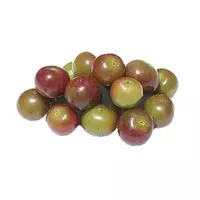Capulin

Capulin or Prunus salicifolia is a small deciduous tree, which according to the scientific classification is assigned to plants from the Rosaceae family. In height, the capulin tree reaches 15 meters and differs in its lanceolate leaves, having an oval shape and not exceeding, as a rule, 18 cm in length.
They eat capulin fruits, which in their appearance resemble some well-known cherries. As a rule, capulin fruits do not exceed 2 cm in diameter and differ in their dark red or almost black color, as well as delicate and glossy peel. The pulp of capulin is juicy and differs in its pale green color.
Inside the capulin is one large seed. Researchers believe that the homeland of capulin can be considered the territory of Mexico, as well as Guatemala. The capulin fruit tree has been cultivated in Central America for thousands of years. Currently, the capulin tree is grown in countries such as Peru, Bolivia, Ecuador, as well as Colombia.
At the beginning of the last century, scientists introduced capulin to the territory of the Philippine islands, where the plant successfully took root. Capulin fruits are eaten in a mixed form. In addition, capulin fruits are subjected to culinary treatment, usually stewed. In Mexico, capulin fruits are used to produce national low-alcohol spirits.
The beauty of the capulin plant is that the fruit tree is completely unpretentious, and in addition it is distinguished by accelerated growth and ripening of fruits. Breeders note that the capulin tree gives fruits in the second year of life. Although exclusively capulin fruits are eaten, the tree is of important importance for residents of the plant distribution region.
Capulin bark is used to make vegetable fiber, on the basis of which strong ropes and burlap are made. Capulin inflorescences have long been used in folk medicine as an effective means to help cope with headache attacks.
It is noteworthy that during flowering, the capulin plant is confused by ignorant people with the well-known bird cherry. White inflorescences of capulin look, and in addition exude a aroma similar to bird cherry. It should be especially emphasized that the bones contained in the fruits of capulin should not be eaten.
Since they contain poisonous substances that can have a negative impact on the state of human health. In Central America, the famous national dessert is made from capulin berries, for which the fruits of the plant are released from the bone, mixed with milk, and then cinnamon is added, as well as vanilla.
capulina 28 kCal
Energy value of capulin (Ratio of proteins, fats, carbohydrates - ju):
Proteins: 1.55 g (~ 6 kCal)
Fats: 0.13 g (~ 1 kCal)
Carbohydrates: 4g (~ 16kCal)
Energy ratio (bj | y): 22% | 4% | 57%
 Español
Español Français
Français Português
Português Русский
Русский 简体中文
简体中文 繁體中文
繁體中文 日本語
日本語 한국어
한국어 العربية
العربية Türkçe
Türkçe Қазақ
Қазақ Deutsch
Deutsch Italiano
Italiano Українська
Українська
